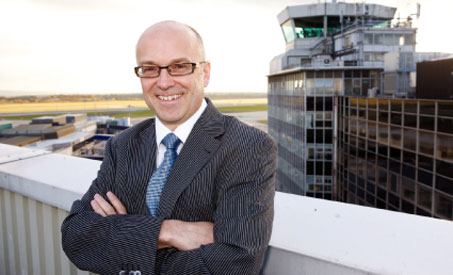
Cornish: “Over the last two years we’ve grown market share and have outperformed the average growth in the UK airport sector.”
Charlie Cornish joined Manchester Airports Group in October 2010. His immediate priority was to undertake a strategic review, and achieve growth in three key areas: passenger numbers, revenues and market share. “Over the last two years we’ve grown market share and have outperformed the average growth in the UK airport sector. We’ve added passenger numbers – Manchester is now the third biggest airport in the UK, whereas a year ago it was the fourth biggest. All of that is quite positive; so we are seeing growing passenger numbers, growing revenues, more routes, and more profitability across MAG – and that is without the addition of London-Stansted,” said Cornish.
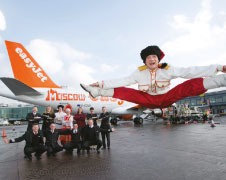
easyJet launched its new Manchester-Moscow route on 28 March, with four weekly flights. The first passengers travelled onboard an aircraft painted with a special Moscow livery, while traditional Russian Cossack dancers performed at the gate. The airline expects to carry around 60,000 passengers on the route in the first year of operations.
He forecasts further modest, single-digit growth across the Group in 2013, which is reflected in Manchester’s latest figures that show a +1.5% year-on-year increase in February to 1.19 million passengers – allowing for the additional leap year day in February 2012, the underlying growth was nearer +5%. “We’ve already secured some opportunities to grow passenger numbers at East Midlands and Manchester, and in due course we’ll look to grow passenger numbers at Stansted as well. We won’t be looking at double-digit growth unfortunately, but we will be looking to continue our upward trajectory,” explained Cornish.
New services in Manchester’s summer schedule include easyJet to Moscow, Norwegian to Stavanger and Ryanair to Warsaw. easyJet’s opportunity to serve the Moscow market resulted from Lufthansa’s decision last year to sell bmi British Midland to International Airlines Group (IAG) – owner of British Airways. The current air service agreement allows for a maximum of two airlines to be designated by both the UK and Russia and, as BA is already one of these, it had to give up BA’s designation on London and Manchester services. easyJet subsequently won the traffic rights, and officially launched Manchester-Moscow services on 28 March. The airline also recently launched three new services from London-Stansted to Marrakech, Sofia and Sharm el Sheikh.
Charlie Cornish biography
Charlie Cornish was appointed CEO of Manchester Airports Group in October 2010. He was previously a Director at United Utilities, where he was Managing Director of United Solutions. He has also held senior positions at Thames Water, NHS Scotland and Trusthouse Forte.
Cornish expects low-cost carriers to drive continued growth at East Midlands Airport. Most recently, Ryanair announced in February the addition of five new routes from East Midlands in its 2013 summer schedule – Girona, Marseille, Menorca, Poznan and Zadar – meaning it will operate a total of 40 routes from the airport.
Measured by weekly seat capacity, Ryanair is the largest airline at all four airports in the freshly expanded MAG. “Ryanair is a very successful airline. It transports about 80 million passengers every year, it has lots of cash on the balance sheet, and if the rumours are true it will be ordering more aircraft. Ryanair is a commercially-orientated company, but its performance is good in terms of price and departure times, so I think as long as you recognise that Ryanair is a growing airline and wants the best commercial deal, as we do, you can develop a long-term, meaningful relationship with them,” commented Cornish.
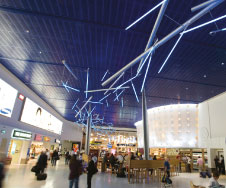
Cornish: “I think Manchester is a little bit different from most regional airports in as much as it’s very well invested – we have three terminals and two runways at Manchester, so we’ve got capacity to grow in the long-term.”
London-Stansted acquisition
A key conclusion of the strategic review was that MAG wished to add a “quality airport” to the Group. “As far back as 18 months ago we started looking up and down the UK, and we thought Stansted was the right opportunity for us,” commented Cornish.
MAG announced the completion of its £1.5 billion (€1.8bn) London-Stansted acquisition from LHR Airports Ltd (formerly known as BAA) on 28 February. BAA was required to sell the airport following a UK Competition Commission ruling originally made in March 2009. As part of the transaction, Industry Funds Management (IFM) became an investor in MAG, taking a 35.5% interest in the enlarged group, having work in close partnership with MAG throughout the acquisition process. IFM has investments in five major Australian airport companies – Adelaide, Brisbane, Melbourne, Northern Territory Airports and Perth.
The acquisition consolidates MAG’s position as the UK’s third largest airport group, after LHR Airports Ltd (Aberdeen, Glasgow, London-Heathrow and Southampton), and Global Infrastructure Partners (Edinburgh, London-City and London-Gatwick). The expanded MAG’s total annual throughput of 44 million means it has closed the gap to GIP to just 4.5 million passengers.
London-Stansted Airport
Annual passengers: 17.4 million
No. of destinations: 150
Top 3 airlines: Ryanair, easyJet, Germanwings
London-Stansted, with 17.4 million annual passengers, is the fourth biggest airport in the UK – after London-Heathrow, London-Gatwick and Manchester. “It makes us a sizeable player and having looked at the London market, which is resilient and is one of the biggest aviation markets in the world in terms of passengers, we’re fairly confident in the long-term that Stansted will grow. It’s probably about 50% utilised at this moment in time, so in the long-term, it’s inevitable that we’ll get significant growth at Stansted,” said Cornish. “If you look at the multiples on recent airport acquisitions, such as Stansted, I think they demonstrate a degree of confidence in the airports sector.”
The £1.5 billion (€1.8bn) paid for Stansted represents an acquisition multiple of 15.6 times 2012 EBITDA (Earnings Before Interest, Taxes, Depreciation and Amortization), reflecting confidence in the airport’s significant growth potential. “We would only have bought Stansted if it added value for shareholders, both in terms of capital growth and long-term cash receipts, so we’re fairly confident we’ll add quite a lot of shareholder value over the next 20 years,” explained Cornish. “We’ll do that in a number of ways. In the short-term, we’ll stimulate growth with the current airlines. In the medium-term, we’ll look to bring in a richer mix of carriers.”
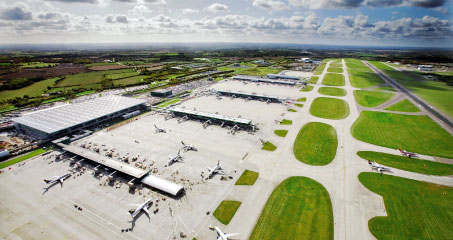
Manchester Airports Group completed its £1.5 billion (€1.8bn) acquisition of London-Stansted in February. Cornish: “It makes us a sizeable player and having looked at the London market, which is resilient and is one of the biggest aviation markets in the world in terms of passengers, we’re fairly confident in the long-term that Stansted will grow.”
MAG is wasting no time in identifying potential improvements at London-Stansted. It is already planning a £40 million (€47m) investment to enhance the layout of the retail and security areas. The idea is that this will create more airside retail opportunities, leading to an increase in non-aeronautical revenues. “We’re finalising the design of those plans now and will be starting work imminently, with a view to completion during this calendar year. So we’ve got good plans for Stansted, which will take the airport forward,” commented Cornish.
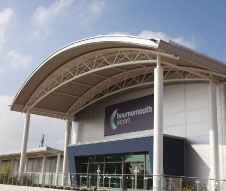
Bournemouth Airport’s new arrivals hall opened in 2011. It features a range of energy efficiency measures, including 323 solar panels on the roof and a computerised building management system that controls the heating, cooling and lighting.
Aviation taxation
MAG is a member of the ‘A Fair Tax On Flying’ campaign – a coalition of airlines, airports and trade associations, which calls for reform of the UK’s Air Passenger Duty (APD). In his March Budget statement, UK Chancellor George Osborne announced that APD would increase on 1 April 2013, and again on 1 April 2014, in line with the Retail Prices Index (RPI) measure of inflation (currently 3.2%). Cornish stressed that rises in APD are damaging to the UK’s global competitiveness. He speaks passionately about the detrimental impact of APD on aviation and the wider economy. “It just seems a bit strange that almost every country in Europe has taken aviation taxation away on the basis that they believe it will stimulate growth in the economy, yet the UK Government is still short-sighted and doesn’t seem to be willing to stimulate growth; it is more interested in keeping short-run taxation high,” he stated.
Offering his view on the current situation of the UK airport market, he added: “What you generally find is that UK airports tend to mirror GDP. If you look back over 20 years, airports tend to outperform GDP by around 1.4 times. Obviously when GDP is low it has a bearing on passenger numbers, and consumer confidence is still a bit low at this moment in time. So there are a number of economic factors that we have to deal with – one is low GDP which dampens growth, another is UK aviation taxation which is just about the highest in Europe, which is a particularly important factor for regional airports. I think the prognosis is that there are some very, very early green shoots of recovery across the sector, but that recovery would be greatly helped if the government could get its head around having taxation aligned with other European countries.”
Manchester – UK’s northern gateway
MAG sees Manchester Airport as the UK’s “northern gateway”, and Cornish strongly believes that it is well-placed to alleviate some of the capacity constraints that exist in the south-east. “I think Manchester is a little bit different from most regional airports in as much as it’s very well invested – we have three terminals and two runways at Manchester, so we’ve got capacity to grow in the long-term,” he explained. “The infrastructure is there, and as the northern gateway, Manchester is well connected from Birmingham all the way up to Scotland. More importantly, we also have good, solid relationships with long-haul carriers, including Emirates, Etihad, Qatar Airways, Singapore Airlines, American Airlines, Delta Air Lines, Turkish Airlines and Virgin Atlantic.”
In February, MAG launched its ‘Fly Manchester’ campaign to win back the four million annual passengers from its catchment area that currently travel south to one of the London airports to fly. The year-long campaign will highlight the importance of regional hubs in alleviating congestion, with an advertising effort in key target areas.
“We have a lot of direct, long-haul services, so our preference is to try and persuade more people in the local catchment area to fly from Manchester. That’s what the ‘Fly Manchester’ campaign is all about – it’s about boosting capacity on our existing long-haul routes, and also demonstrating the need for additional capacity in Manchester,” said Cornish. “Clearly we want to grow Manchester and we see that it has the potential for growth in terms of direct long-haul services.”
Manchester Airport
Annual passengers: 22 million
No. of destinations: 225
Top 3 airlines: Ryanair, easyJet, Flybe
Manchester Airport City
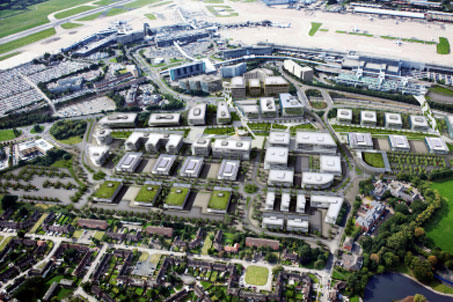
Planning approval for the £650 million (€760m) Manchester Airport City development was granted in January. It is expected to create around 20,000 jobs and further Manchester’s ambition to become a major European and global business city.
A flagship development is Manchester Airport City – a £650 million (€760m) development programme that will be undertaken over the next 10-15 years. Planning approval was granted in January for the development, which will include new offices, industrial units, retail and leisure facilities. “We’re now busy looking at the opportunities of bringing some tenants in to the airport. We will soon appoint one or more development partners to work with us on the marketing and construction and development activity, and that will be a fairly big catalyst,” stated Cornish. “Overall, it’s got the potential to create around 20,000 jobs in the local environment. The more economic benefit we bring, the more companies we bring in to the airport, the greater likelihood there is that we’ll get more passengers going through the airport.”
The planning approval enables MAG to progress to the delivery stage in 2013, providing the opportunity to attract investment and create jobs. It is hoped that the development will not only enhance Manchester Airport’s position as the global gateway to the north of the UK, but also further Manchester’s ambition to become a major European and global business city.
MAG Developments is also developing 540,000 sq ft of business space – including offices, industrial units, warehousing, and aviation hangars – at its Aviation Business Park at Bournemouth Airport. The 10-year master plan will see an investment of £60 million (€70m).
Bournemouth Airport
Annual passengers: 600,000
No. of destinations: 35
Top 3 airlines: Ryanair, Thomson, Aer Arann
East Midlands upgrade
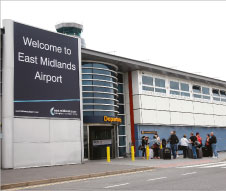
There are plans for a £12 million (€14m) terminal upgrade at East Midlands Airport. This will provide a streamlined, intuitive passenger journey with a reconfigured terminal layout, including an enhanced retail offer, and a major refurbishment of the security search area.
Cornish outlined plans to enhance the traveller experience at East Midlands Airport with a £12 million (€14m) terminal upgrade. This will provide a streamlined, intuitive passenger journey with a reconfigured terminal layout, including an enhanced retail offer, and a major refurbishment of the security search area. The project will be completed by the end of 2013.
“What we’re looking to do at East Midlands, Manchester and Stansted, is to introduce the latest technology for automatic boarding card readers. We’re also looking to introduce different types of security lane configuration, so we can get passengers through security quicker. So we continue to look at every opportunity to make the whole passenger journey more seamless and easier to navigate as we go forward,” explained Cornish.
As part of East Midlands’ commitment to environmental sustainability, its refurbishment incorporates the use of more natural daylight to reduce the need for lighting, and increased ventilation to provide cooling. It is estimated that this will save approximately 315 tonnes of carbon emissions annually and provide a 15% reduction in energy usage.
East Midlands Airport
Annual passengers: 4.2 million
No. of destinations: 90
Top 3 airlines: Ryanair, Flybe, Jet2.com
MAG is noted for its proactive environmental approach, and Manchester Airport, which is Airport Carbon Accredited at the ‘Optimisation’ level, won the Eco-Innovation Award at the 2012 ACI EUROPE Best Airport Awards. Meanwhile, in 2012 East Midlands was the first UK airport to become carbon neutral in its ground operations.
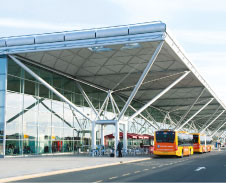
Manchester Airports Group is already planning a £40 million (€47m) investment to enhance the layout of the retail and security areas at London-Stansted. Cornish: “We would only have bought Stansted if it added value for shareholders, both in terms of capital growth and long-term cash receipts, so we’re fairly confident we’ll add quite a lot of shareholder value over the next 20 years.”
“The main initiatives we’re looking at currently are opportunities to increase energy efficiency, as well as sustainable lighting and heating. In the longer-term, we’ll look at getting more energy from waste, so we continue to explore technological innovations,” said Cornish. “We have also recently piloted battery powered vehicles for use at East Midlands Airport, and I think as technology improves on that particular line, we’d like to pursue electric and other alternatively powered vehicles.”
MAG is clearly more than simply a regional success story; its portfolio of airports and property business contributes more than £3 billion (€3.5bn) to the UK economy and supports thousands of jobs. The acquisition of London-Stansted fulfils MAG’s desire to add another “quality airport” to the Group. All of this is indicative of its ambitious strategy to compete in the London market, to win back passengers in its home turf and increase shareholder value by generating profitable growth. “These are exciting times for Manchester Airports Group and I am optimistic about the year ahead,” concluded Cornish.







